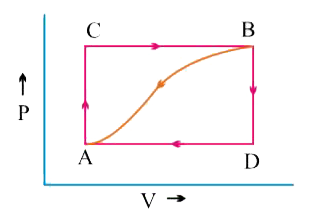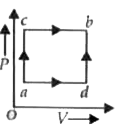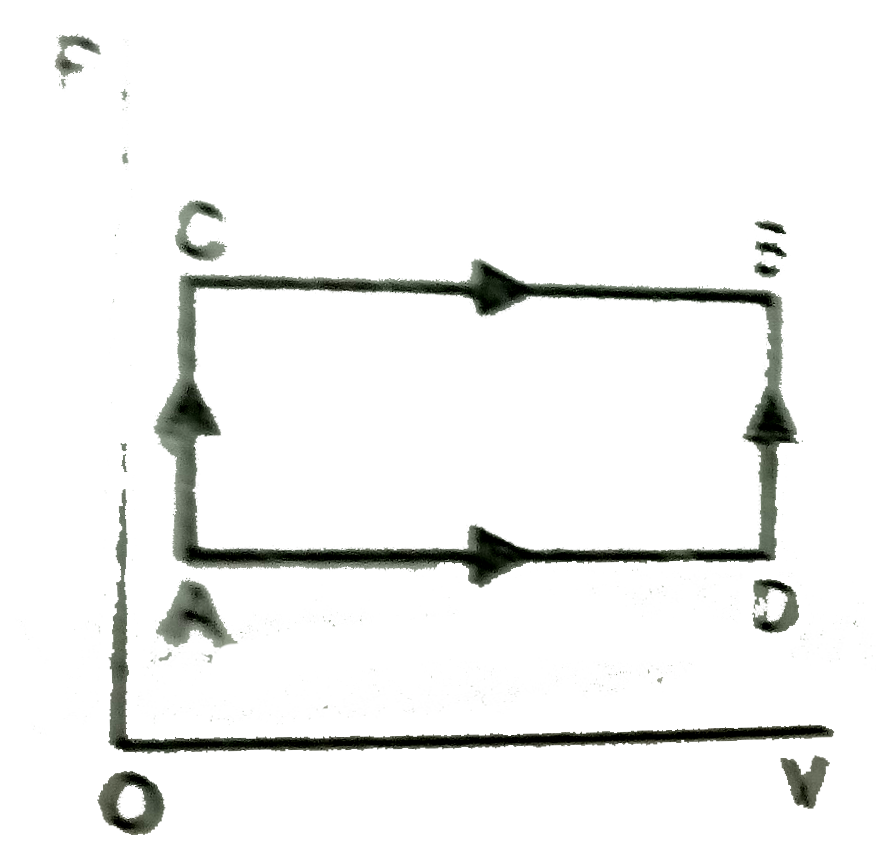When a system is taken from state A to state B along the path ACB, 80 k cal of heat flows into the system and 30 k cal of work is done.
If UA=0andUD=40 k cal, find the heat absorbed in the process AD

UA=0,UD=40kcal
duAD=40kcal
dwADB=10kcal
dwDB=0sincedV=0
dQAD=40+10=50 k cal
Topper's Solved these Questions
- BOOK - CBSE COMPLEMENTARY MATERIALCHAPTER - THERMODYNAMICS EXERCISE - MULTIPLE CHOICE QUESTIONS (MCQs)20videos
THERMODYNAMICS
- BOOK - CBSE COMPLEMENTARY MATERIALCHAPTER - THERMODYNAMICS EXERCISE - LONG ANSWER TYPE QUESTIONS (5 MARKS)1videos
THERMODYNAMICS
- BOOK - CBSE COMPLEMENTARY MATERIALCHAPTER - ROTATIONAL MOTION EXERCISE - MULTIPLE CHOICE QUESTIONS20videos
ROTATIONAL MOTION
- BOOK - CBSE COMPLEMENTARY MATERIALCHAPTER - WORK, ENERGY AND POWEREXERCISE - MCQ20videos
WORK, ENERGY AND POWER
Similar Questions
When a system is taken from state A to state B along the path ACB, 80 k cal of heat flows into the system and 30 k cal of work is done.
How much heat flows into the system along path ADB if the work done is 10 k cal ?View SolutionWhen a system is taken from state A to state B along the path ACB, 80 k cal of heat flows into the system and 30 k cal of work is done.
How much heat flows into the system along path ADB if the work done is 10 k cal ?
When the system is returned from B to A along the curved path the work done is 20 k cal. Does the system absorb or liberate heat.View Solution
Knowledge Check
- Question 1 - Select One
When a system is taken from state A to state B along path ACB as shown in figure below, 80J of heat flows into the system and the system does 30J of work.

If ED−EA=−40J, the heat absorbed in the processes AD and DB are respectivelyAqAD=30J and qDB=−90JBqAD=−60J and qDB=30JCqAD=30J and qDB=90JDqAD=−30J and qDB=90J - Question 2 - Select One
When a system is taken from stata a to state b along the path acb as shown in figure, 60 J of heat flows into the system and 30 J of work is done by the system. Along the path adb, if the work done by the system is 10 J, heat flow into the system is
 A100 JB20 JC80 JD40 J
A100 JB20 JC80 JD40 J
When a system is taken from state A to state B along path ACB as shown in figure below, 80J of heat flows into the system and the system does 30J of work.

If ED−EA=−40J, the heat absorbed in the processes AD and DB are respectivelyView SolutionWhen a system is taken from state a to state b, in figure along the path a→c→b, 60J of heat flow into the system, and 30J of work is done :
(i) How much heat flows into the system along the path a→d→b if the work is 10J.
(ii) When the system is returned from b to along the curved path, the work done by the system is −20J. Does the system absorb or liberate heat, and how much ?
(iii) If , Ua=0 and Ud=22J, find the heat absorbed in the process a→d and d→b.
_S01_052_Q01.png) View Solution
View SolutionWhen a system is taken from state a to state b, in figure along the path a→c→b, 60J of heat flow into the system, and 30J of work is done :
(i) How much heat flows into the system along the path a→d→b if the work is 10J.
(ii) When the system is returned from b to along the curved path, the work done by the system is −20J. Does the system absorb or liberate heat, and how much ?
(iii) If , Ua=0 and Ud=22J, find the heat absorbed in the process a→d and d→b.
_S01_052_Q01.png) View Solution
View SolutionIn given figure, when a thermodynamic system is taken from state A to state B via path ACB,100 cal of heat given to the system and 60cal work is done by the gas. Along the path ADB, the work done by the gas is 20cal. Find the heat flowing into the system in this case?
 View Solution
View SolutionIn given figure, when a thermodynamic system is taken from state A to state B via path ACB,100 cal of heat given to the system and 60cal work is done by the gas. Along the path ADB, the work done by the gas is 20cal. Find the heat flowing into the system in this case?
 View Solution
View SolutionIn given figure, when a thermodynamic system is taken from state A to state B via path ACB, 100 cal of heat given to the system and 60 cal work is done by the gas. Along the path ADB, the work done by the gas is 20 cal. Find the heat following into the system in this case ?
View Solution

